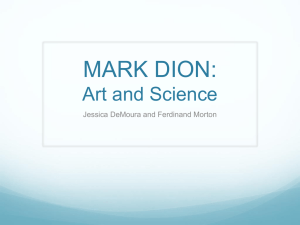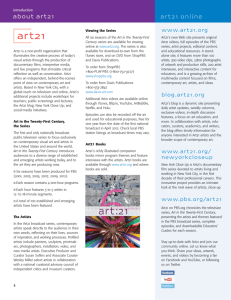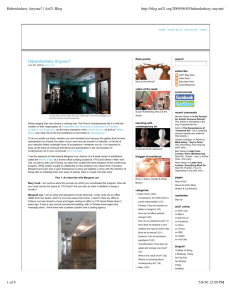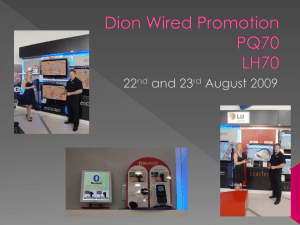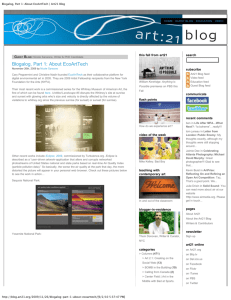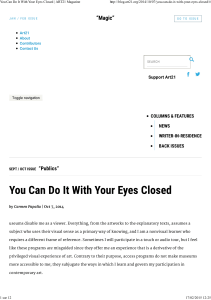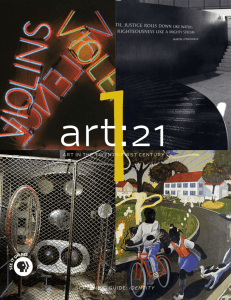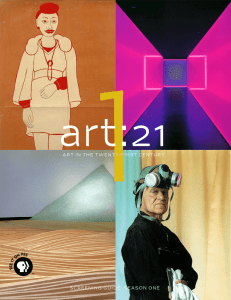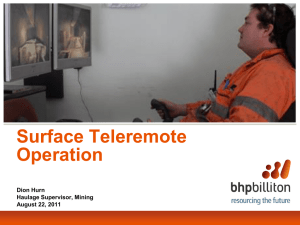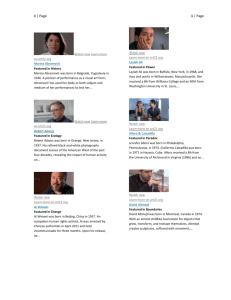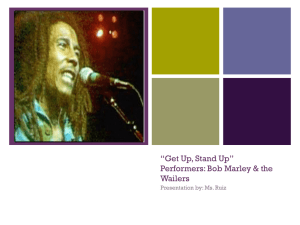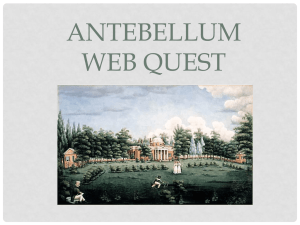Mark Dion PowerPoint
advertisement
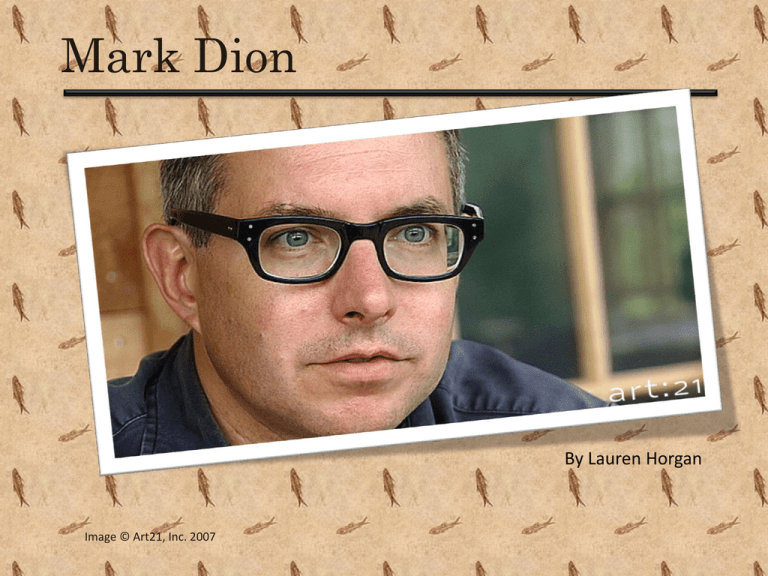
Mark Dion By Lauren Horgan Image © Art21, Inc. 2007 Mark Dion was born in New Bedford, Massachusetts in 1961 Currently, he lives and works in Beach Lake, Pennsylvania He studied at the School of Visual Arts from 1982-1984 He graduated from the University of Hartford in 1986 with a Bachelor’s degree in Fine Art. He also received an honorary doctorate from Hartford in 2003. Was the 9th recipient of the Larry Aldrich Award 2001, and also received the Lucelia Artist Award in 2008. Describes himself as a guy who likes to shop and surround himself with many different types of “stuff”. He uses the funky things he buys to make his art. Source: http://pbs.org “I consider myself a visual artist with a keen interest in the science of life. My work is mostly about exploring questions around the representation of nature, which means, that rather than being about nature, it is concerned with ideas about nature.” Dion’s art is about people’s ideas about nature. His work has to do with humans’ understandings and misunderstandings about our natural world. Through his art, he both critiques and admires museums and the method in which they present information about science, nature, and art. Source: http://www.cmoa.org Ecology Environmentalism Consumer Culture Archaeology Source: http://www.cmoa.org Science Dion’s ideas are influenced by science, and while making his art he works with scientists. Alexander Wilson Illustrator, naturalist, and ornithologist. Wilson was famous for his illustrations of birds. What does Dion mean by “ideas about nature”? “…my work tries to investigate what nature means for a particular group of people, in a particular place at a distinct point in history. Our ideas about the natural world shift over time…” Image © Art21, Inc. 2007 Some examples of such ideas: Protecting the environment Recycling, clean energy, and other methods of conservation are fairly new ideas in history. Taxonomy Dion also addresses the established classification of objects, questioning them and what people assume they know about those objects. Image © Art21, Inc. 2007 Vivarium: a transparent enclosure in which small animals are kept so that their behavior can be studied A 60ft long tree enclosed in an 80ft greenhouse located in Olympic Sculpture Park in Seattle, WA. "The tree is essentially an optimistic organism, giving life through its death, but it is also an organism that is out of context. It’s nostalgic for its original site. It’s a memento mori, an appreciation of decay as a process, and a tool for discourse. And that’s really how I imagine it, because it isn’t a natural system. It is really a garden we’re making. It’s a garden that emphasizes a particular natural process." Image © Art21, Inc. 2007 This is an installation. You will soon see that much of Mark Dion’s work is installation art. Dion himself said that he specifically likes to make art on site at a particular place. Image © Art21, Inc. 2007 What is an installation? Dion: “I don’t want people to see my work only through representations, through images. I want them to be able to move through the spaces. It’s important that things have a texture, a smell, a feeling . . . something that you can never capture from a photograph.“ Installations are SITE-SPECIFIC. Often in an installation, the participation of the audience is part of the artwork itself. "I’m very interested in surrounding myself with the stuff that inspires me. I’m an artist who gets a lot from things, and in that way I’m very much a sculptor. I really love the world of stuff. I know a lot of artists who prefer to have very Spartan lives. Their inspiration is very much in their heads. They like clean, white, empty New York kinds of spaces. But I really like the surprising juxtapositions when you put things together on the bookshelf and when you start to collect things." Image © Art21, Inc. 2007 What are some of the objects Dion juxtaposed in this installation? http://www.pbs.org/art21/slideshow/popup.php?slide= 1403 Books Tree Picture Frames Birds Jars Basket How can you use the ‘stuff’ in your house to create an interesting work of art? Image © Art21, Inc. 2007 Here Dion is trying to capture the moment when the artist realizes how much work he has ahead of him if he wants to perfect his skill. The many watercolor owls scattered around the desk reflect the notions of diligence and practice. Image © Art21, Inc. 2007 "We are trying to tell our story, our cosmology, our way of understanding the world, through our work in the same way as the Renaissance painters who were doing Annunciation and Crucifixion scenes. Each one of them did it differently- just as artists like me and Matthew Ritchie or Alexis Rockman, or any of the other artists who are interested in these kinds of things, will use different languages to tell the same story." Image © Art21, Inc. 2007 What do you think Mark Dion is trying to say with this installation? What is the big idea? http://www.pbs.org/art21/slideshow/p opup.php?slide=1387 Image © Art21, Inc. 2007 “I was a child who had collections and was constantly in search of things like butterfly nets and cigar boxes. These things still have a particular attraction…. As I go through museums, I see that a lot of the motivation of curators and people who are scientifically trained comes from finding productive ways of using these impulses. FOCAL POINT What stands out to you the most in this picture? Where is your eye drawn to? http://www.pbs.org/art21/slideshow/popup.p hp?slide=2186 Image © Art21, Inc. 2007 Curiosity Cabinets Image © Art21, Inc. 2007 The Department of Marine Animal Identification of the City of New York (Chinatown Division) Image © Art21, Inc. 2007 Polar Bear and Toucans (From Amazonas to Svalbard) Landfill http://www.pbs.org/art21/slideshow/popup.php?slide=1386 Understanding the interrelatedness of things is interesting to me, and I think that it’s something that we often miss in our culture- being able to see the connections between things, between our actions, our personal behaviors, and the way they affect a broader field, the rest of the world for example. Mobile Biotype A greenhouse on wheels Source: http://www.artnet.com, http://www.pbs.org Installation art: An artistic genre of site-specific, three-dimensional works designed to transform the perception of a space. Juxtaposition [juxtapose]: To place two or more things together, especially in order to suggest a link between them or emphasize the contrast between them. Focal Point: The center of attention, or area of interest. Ornithology: The branch of zoology that deals with the scientific study of birds. Taxidermy : The act of mounting or reproducing dead animals for display or for sources of study. Taxonomy: The practice and science of classification. Vivarium: a transparent enclosure in which small animals are kept so that their behavior can be studied http://www.cmoa.org/international/html/art/dion.htm http://ucsdnews.ucsd.edu/newsrel/arts/visart_dion.htm http://www.wikipedia.org/ http://www.aldrichart.org/exhibitions/past/dion.php http://the-artists.org/artist/Mark-Dion http://network.nature.com/hubs/london/events/1149 http://tate.org
